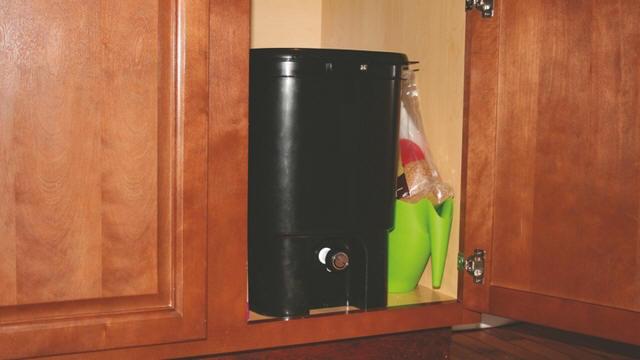Composting adventures: All quiet on the compost front
- November 2, 2012
- By Kerri Jansen
 Kerri Jansen | Waste & Recycling News
Food scraps are cooking inside my bokashi
bucket. I'll open it soon to see if it turned into compost.
Kerri Jansen | Waste & Recycling News
Food scraps are cooking inside my bokashi
bucket. I'll open it soon to see if it turned into compost.
Editor's note: Waste & Recycling News reporter Kerri Jansen is writing about her experience with bokashi composting, a new type of composting developed in Japan and gaining popularity in the U.S. This is part 7 of her story.
Now that I'm no longer adding scraps to my bokashi composting bin multiple times a day, I tend to forget it's still loitering under my kitchen sink. There's no odor; the putrefying organics are sealed tightly inside the bin. And it's completely silent, with none of the gurgling or bubbling noises you'd expect from a fermentation process. The bin only sees any action when I drain the bokashi tea every few days.
The stream of liquid I drain from the bin tends to sputter. When organic material decomposes without oxygen, it produces methane, a gas that contributes to global warming. The microbes in the bokashi bran I added, as well as the highly acidic conditions inside the bin, are supposed to remove that problem. But it seems some gas is still being produced, whether it's methane or something else. With no vent in the bin, the gas is escaping through the bin's spigot each time I open it.
This method of composting is catching on in the U.S. – slowly. There are bokashi composting users scattered throughout North America, and a handful of hobbyists provide information and tips online, but it's not a widespread method. And major environmental organizations remain silent on the subject.
The U.S. Composting Council responded to an inquiry on its website by saying that the organization "does not provide any information directly on the use of effective microorganisms," the special mix of microbes found in bokashi bran. The U.S. EPA's website offers information for a range of composting methods – from backyard composting to wormy vermicomposting – but doesn't list a page for bokashi.
The U.S. may be a bit late to the bokashi scene, but the method is more popular in some other areas. Borneo, an island in southeast Asia, recently made headlines for its bokashi composting program: seven government agencies and a hospital now use bokashi barrels to process their kitchen and organic waste. If this catches on in the U.S., maybe a bokashi bin would find its way to the White House. That's something I'd like to see.
My bokashi composting experiment is nearing its end. After letting the contents of the compost bin ferment for about two weeks, I'll be unsealing the bin this weekend and, of course, sharing all the messy details with you. Look for the conclusion of my month-long project next week.
![]()
w w w . w a s t e r e c y c l i n g n e w s . c o m
copyright 2012 by Crain Communications Inc. All rights reserved.